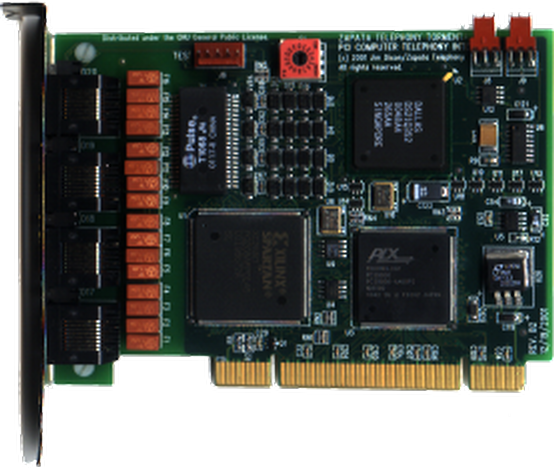| ||
| ||
| ||
| ||
| ||
|
T/E100P Interface Card
Description: OpenSS7 Hardware Selection T100P/E100P.
 These cards are no longer supplied. It may be possible to obtain used or surplus cards on
computer auction websites. Consider using one of the recent
C100P/E cards instead. These cards are no longer supported by any
OpenSS7 driver.
These cards are no longer supplied. It may be possible to obtain used or surplus cards on
computer auction websites. Consider using one of the recent
C100P/E cards instead. These cards are no longer supported by any
OpenSS7 driver.
The T100P and E100P cards are 1- T1 or E1 port PCI cards manufactured by Digium and Varion. The figure below shows a picture of a T100P card.
The T/E100P cards have the lowest level of signalling performance due to the lack of on-board HDLC functions. Transfers to the host processor over the PCI bus use PCI I/O ports and memory mapping.
Driver
These cards are supported by the X100 driver. (But see the Status page for this card.)
The function of the T/E100P Channel driver is to provide for the termination of 2.048Mbps, 1.544Mbps, 64kbps and 56kbps digital paths. This driver provides direct access to the channelized or unchannelized T1 or E1 digital paths to OpenSS7 media and signalling protocol modules as well as providing T1 or E1 management, framing, coding, alarms, and synchronization.
Features
Following are some features of the T100P and E100P cards:
- 1 T1 or E1 span per card.
- Dallas framer.
- PLX PCI 9030 PCI bus chip.
- Xilinx Spartan XC2S50 processor.
- Raw transfer of octets from framers to PCI bus.
- Uses OpenSS7 Soft-HDLC engine for SS7, ISDN and ISO.
- 24 channels per card (T1)
- 32 channels per card (E1).
- Full span addressable.
Advantages
Following are the advantages of the T100P and E100P cards:
- Medium cost.
- PC Compatibility.
- Flash programmable Xilinx chip.
- Field upgradable.
- Supports a number of Open Source drivers.
- Zaptel driver support.
Disadvantages
Following are the disadvantages of the T100P and E100P cards:
- Lowest performance.
- No on-board HLDC.
- Cannot TDM switch on card or between cards, media channels must be transferred through host to switch between cards.
- I/O Port and Memory Map instead of PCI DMA bus-mastering and burst transfers.
- Does not run on high speed buses.
- No integrated Ethernet for SIGTRAN and VoIP applications.
- Synchronization per-card instead of per-system.
Ultimately, the performance limiting factor of the T/E100P cards is the bandwidth of the PCI bus and the ability of the processor to perform Soft-HDLC and TDM switching in software. A 350MHz processor is capable of processing the bandwidth of an entire E100P card (32 signalling links) with a combined link throughput of 2.048 Mbps.
For the OpenSS7 VoIP Switch, this performance is too small and does not scale. A medium grade 2GHz PC should be capable of handling 8 cards (248 SS7 links) with adequate excess capacity available for background operations.
These cards are cost-effective and can provide 64kbps SS7 links at average incremental interface cost of approximately $8.00 USD per signalling link.
Disclaimer
 Note:
Some of the information in this hardware selection guide may be incomplete, incorrect, out of
date, or inconsistent with the vendor's actual offerings.
Also note that this hardware selection guide does not constitute an endorsement of anyone's
product or service. The authors of the OpenSS7, their sponsors, agents and representatives will
not take responsibility in it.
Note:
Some of the information in this hardware selection guide may be incomplete, incorrect, out of
date, or inconsistent with the vendor's actual offerings.
Also note that this hardware selection guide does not constitute an endorsement of anyone's
product or service. The authors of the OpenSS7, their sponsors, agents and representatives will
not take responsibility in it.
Please use good business sense when considering any vendor's products and consult with the individual vendor before making any decisions. Please do, however, investigate the product and service offerings of the sponsors listed on our Sponsors page: it is through your support of our sponsors that the OpenSS7 Project exists and is funded to continue.
Copyright © 2014 OpenSS7 Corporation All Rights Reserved.
